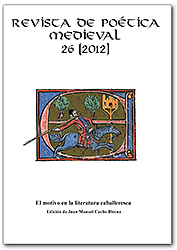«De vuelta sobre la seducción en los libros de caballerías. Con especial atención a la figura masculina y el ‘donjuanismo’»
DOI:
https://doi.org/10.37536/RPM.2012.26.0.30551Abstract
Resumen: Este artículo aborda el motivo del caballero seductor y mujeriego, antecedente del Don Juan de Tirso de Molina, que corresponde en el catálogo de Stith Thompson al motivo T10.4 (G), “Man continually falling in love”. Se hace una revisión de los herederos de Gauvain artúrico en los libros de caballerías castellanos, con especial atención a Galaor en el Amadís de Gaula, Rogel de Grecia del Florisel de Niquea y Floriano del Desierto del Palmerín de Inglaterra para descubrir los rasgos que los hermanan y que los hacen transgresores del ideal de amor cortés de fidelidad y servicio a una sola dama.
Palabras clave: Libros de caballerías. Seducción. Caballero mujeriego. Amadís de Gaula. Florisel de Niquea. Palmerín de Inglaterra.
Abstract: This article approaches the motive of the seductive and womanizer knight, antecedent of Tirso’s de Molina Don Juan, which corresponds to the motive T10. 4 (G) on Stith Thompson’s Index, “Man continually falling in love”. It makes a revision of arturic Gauvain’s heirs on the castilian romances of chivalry, with special attention to Galaor on the Amadis de Gaula, Rogel de Grecia from Florisel of Niquea and Floriano del Desierto from Palmerín de Inglaterra, in order to discover the twinning features among them, that also make them transgressors of the ideal of courtly love and service to one lady.
Keywords: Chivalric romances. Seduction. Womanizer knight. Amadís de Gaula. Palmerín de Inglaterra. Florisel de Niquea.
Downloads
Métricas alternativas
Downloads
How to Cite
Issue
Section
License
The opinions and facts stated in each article are the exclusive responsability of the authors. The University of Alcalá is not responsible in any case for the credibility and aunthenticity of the studies.
Authors will retain the rights on their work, even if they will be granting the journal a non-exclusive right of use to reproduce, edit, distribute, publicly communicate and show their work. Therefore, authors are free to enter into additional, independent contracts for non-exclusive distribution of the works published in this journal (such as uploading them to an institutional repository or publishing them in a book), as long as the fact that the manuscripts were first published in this journal is acknowledged.
Works are published under the terms stipulated in the Attribution-NonCommercial-ShareAlike 4.0 International License (CC BY-NC-SA 4.0) that allows third parties to share the work under the following conditions:
Attribution — You must give appropriate credit, provide a link to the license, and indicate if changes were made. You may do so in any reasonable manner, but not in any way that suggests the licensor endorses you or your use.
NonCommercial — You may not use the material for commercial purposes.
ShareAlike — If you remix, transform, or build upon the material, you must distribute your contributions under the same license as the original.










